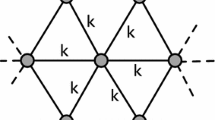Abstract
Mass spring models (MSMs) are a popular choice for representation of soft bodies in computer graphics and virtual reality applications. In this paper, we investigate physical properties of the simplest MSMs composed of mass points and linear springs. The nodes are either placed on a cubic lattice or positioned randomly within the system. We calculate the elastic moduli for such models and relate the results to other studies. We show that there is a well-defined relationship between the geometric characteristics of the MSM systems and physical properties of the modeled materials. It is also demonstrated that these models exhibit a proper convergence to a unique solution upon mesh refinement and thus can represent elastic materials with a high precision.















Similar content being viewed by others
References
Baudet, V.; Beuve, M.; Jaillet, F.; Shariat, B.; Zara, F.: Integrating tensile parameters in 3D mass-spring system. Technical Report RR-LIRIS-2007-004, LIRIS UMR 5205 CNRS/INSA de Lyon/Université Claude Bernard Lyon 1/Université Lumiére Lyon 2/École Centrale de Lyon, February (2007)
Bower, A.F.: Applied Mechanics of Solids. CRC Press, Taylor & Francis, Boca Raton (2009)
Delingette, H.: Triangular springs for modeling nonlinear membranes. IEEE Trans. Vis. Comput. Gr. 14(2), 329–341 (2008)
Hardy, R.J.: Formulas for determining local properties in molecular-dynamics simulations—shock waves. J. Chem. Phys. 76, 622–628 (1982)
Kot, M., Nagahashi, H., Szymczak, P.: Verification of physical properties of materials modeled with mass-spring systems. Technical report of IEICE. Multimed. Virtual Environ. 110(457), 201–206 (2011)
Ladd, A.J.C., Kinney, J.H.: Elastic constants of cellular structures. Phys A Stat. Theor. Phys 240(1–2), 349–360 (1997)
Lakes, R.S.: Deformation mechanisms in negative Poisson’s ratio materials: structural aspects. J. Mater. Sci. 26, 2287–2292 (1991)
Landau, L.D., Lifshitz, E.M.: Theory of elasticity. Pergamon, London (1959)
Levine JA, Bargteil AW, Corsi C, Tessendorf J, Geist R (2014) A peridynamic perspective on spring-mass fracture. In Proceedings of the ACM SIGGRAPH/Eurographics Symposium on Computer Animation
Liu, T., Bargteil, A.W., O’Brien, J.F., Kavan, L.: Fast simulation of mass-spring systems. ACM Trans. Gr. 32(6):209:1–7, Proceedings of ACM SIGGRAPH Asia 2013, Hong Kong. (2013)
Lloyd, B.A., Szekely, G.: Harders M (2007) Identification of spring parameters for deformable object simulation. IEEE Trans. Vis. Comput. Gr. 13(5), 1081–1094 (2007)
Love AEH (1906) A treatise on the mathematical theory of elasticity. Cambridge University Press
Meier, U., López, O., Monserrat, C., Juan, M.C., Alcañiz, M.: Real-time deformable models for surgery simulation: a survey. Comput. Methods Prog. Biomed. 77(3), 183–197 (2005)
Nealen, A., Müller, M., Keiser, R., Boxerman, E., Carlson, M., Ageia, N.: Physically based deformable models in computer graphics. Comput. Graph. Forum 25(4), 809–836 (2006)
Ostoja-Starzewski, M.: Lattice models in micromechanics. Applied Mechanics Reviews 55(1), 35–60 (2002)
Press, W.H., Teukolsky, S.A., Vetterling, W.T., Flannery, B.P.: Numerical Recipes: The Art of Scientific Computing, 3rd edn. Cambridge University Press, New York (2007)
San-Vicente, G., Aguinaga, I., Celigueta, J.T.: Cubical mass-spring model design based on a tensile deformation test and nonlinear material model. IEEE Trans. Vis. Comput. Gr. 18(2), 228–241 (2012)
Torquato, S.: Random Heterogeneous Materials: Microstructure and Macroscopic Properties. Springer, New York (2002)
Van Gelder, A.: Approximate simulation of elastic membranes by triangulated spring meshes. J. Graph. Tools 3(2), 21–42 (1998)
Zimmerman, J.A., WebbIII, E.B., Hoyt, J.J., Jones, R.E., Klein, P.A., Bammann, D.J.: Calculation of stress in atomistic simulation. Model. Simul. Mater. Sci. Eng. 12(4), S319 (2004)
Acknowledgments
M.K. and H.N. acknowledge the support of JSPS KAKENHI (Grant Number 24300035). P.S. acknowledges the support of the National Science Centre (Poland) under research Grant No. 2012/07/E/ST3/01734.
Author information
Authors and Affiliations
Corresponding author
Rights and permissions
About this article
Cite this article
Kot, M., Nagahashi, H. & Szymczak, P. Elastic moduli of simple mass spring models. Vis Comput 31, 1339–1350 (2015). https://doi.org/10.1007/s00371-014-1015-5
Published:
Issue Date:
DOI: https://doi.org/10.1007/s00371-014-1015-5




